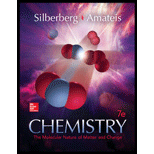
Concept explainers
(a)
Interpretation:
The number of moles present in
Concept introduction:
The number of moles is calculated by the formula:
The formula to calculate mass is as follows:
(a)
Answer to Problem 3.119P
The number of moles present in
Explanation of Solution
The chemical formula for ammonium bromide is
Substitute
In
(b)
Interpretation:
The number of potassium ions in
Concept introduction:
The number of moles is calculated by the formula :
The formula to calculate mass from moles is as follows:
(b)
Answer to Problem 3.119P
The number of potassium ions in
Explanation of Solution
The chemical formula for potassium nitrate is
Substitute
The formula to evaluate the number of ions is as follows:
Substitute
In
(c)
Interpretation:
The mass of
Concept introduction:
The formula to calculate the moles is as follows:
The formula to calculate mass from moles is as follows:
(c)
Answer to Problem 3.119P
The mass of
Explanation of Solution
The molar mass of glycerol
Substitute
The mass of
(d)
Interpretation:
The volume of
Concept introduction:
The number of moles is calculated by the formula:
The relation between density, mass and volume is as follows:
(d)
Answer to Problem 3.119P
The volume of
Explanation of Solution
The chemical formula for chloroform is
Substitute
The density of chloroform is
Rearrange equation (2) for volume as follows:
Substitute
Hence the volume of
(e)
Interpretation:
The number of sodium ions present in
Concept introduction:
The number of moles is calculated by the formula:
(e)
Answer to Problem 3.119P
The number of sodium ions present in
Explanation of Solution
One mole of
The formula to evaluate the number of ions is as follows:
Substitute
The number of sodium ions present in
(f)
Interpretation:
The
Concept introduction:
The symbol and molar mass of cadmium is
The number of moles is calculated by the formula:
The formula to evaluate the number of atoms is as follows:
The conversion factor for converting
(f)
Answer to Problem 3.119P
The number of atoms in
Explanation of Solution
Since
Substitute
In order to calculate the number of atoms from the number of moles substitute
The number of atoms in
(g)
Interpretation:
The number of atoms in
Concept introduction:
The number of moles is calculated by the formula:
(g)
Answer to Problem 3.119P
The number of atoms in
Explanation of Solution
The chemical formula of fluorine gas is
Therefore, the number of fluorine atoms in
In order to calculate the number of atoms from the number of moles substitute
The number of fluorine atoms present in
Want to see more full solutions like this?
Chapter 3 Solutions
Student Study Guide for Silberberg Chemistry: The Molecular Nature of Matter and Change
- Identify any polar covalent bonds in epichlorohydrin with S+ and 8- symbols in the appropriate locations. Choose the correct answer below. Η H's+ 6Η Η Η Η Η Ηδ Η Ο Ο HH +Η Η +Η Η Η -8+ CIarrow_forwardH H:O::::H H H HH H::O:D:D:H HH HH H:O:D:D:H .. HH H:O:D:D:H H H Select the correct Lewis dot structure for the following compound: CH3CH2OHarrow_forwardRank the following compounds in order of decreasing boiling point. ннннн -С-С-Н . н-с- ННННН H ΗΤΗ НННН TTTĪ н-с-с-с-с-о-н НННН НН C' Н н-с-с-с-с-н НН || Ш НННН H-C-C-C-C-N-H ННННН IVarrow_forward
- Rank the following compounds in order of decreasing dipole moment. |>||>||| ||>|||>| |>|||>|| |||>||>| O ||>>||| H F H F H c=c || H c=c F F IIIarrow_forwardchoose the description that best describes the geometry for the following charged species ch3-arrow_forwardWhy isn't the ketone in this compound converted to an acetal or hemiacetal by the alcohol and acid?arrow_forward
- What is the approximate bond angle around the nitrogen atom? HNH H Harrow_forwardOH 1. NaOCH2CH3 Q 2. CH3CH2Br (1 equiv) H3O+ Select to Draw 1. NaOCH2 CH3 2. CH3Br (1 equiv) heat Select to Edit Select to Drawarrow_forwardComplete and balance the following half-reaction in acidic solution. Be sure to include the proper phases for all species within the reaction. S₂O₃²⁻(aq) → S₄O₆²⁻(aq)arrow_forward
- Q Select to Edit NH3 (CH3)2CHCI (1 equiv) AICI 3 Select to Draw cat. H2SO4 SO3 (1 equiv) HO SOCl2 pyridine Select to Edit >arrow_forwardComplete and balance the following half-reaction in basic solution. Be sure to include the proper phases for all species within the reaction. Zn(s) → Zn(OH)₄²⁻(aq)arrow_forwardb. ὋΗ CH3CH2OH H2SO4arrow_forward
 ChemistryChemistryISBN:9781305957404Author:Steven S. Zumdahl, Susan A. Zumdahl, Donald J. DeCostePublisher:Cengage Learning
ChemistryChemistryISBN:9781305957404Author:Steven S. Zumdahl, Susan A. Zumdahl, Donald J. DeCostePublisher:Cengage Learning ChemistryChemistryISBN:9781259911156Author:Raymond Chang Dr., Jason Overby ProfessorPublisher:McGraw-Hill Education
ChemistryChemistryISBN:9781259911156Author:Raymond Chang Dr., Jason Overby ProfessorPublisher:McGraw-Hill Education Principles of Instrumental AnalysisChemistryISBN:9781305577213Author:Douglas A. Skoog, F. James Holler, Stanley R. CrouchPublisher:Cengage Learning
Principles of Instrumental AnalysisChemistryISBN:9781305577213Author:Douglas A. Skoog, F. James Holler, Stanley R. CrouchPublisher:Cengage Learning Organic ChemistryChemistryISBN:9780078021558Author:Janice Gorzynski Smith Dr.Publisher:McGraw-Hill Education
Organic ChemistryChemistryISBN:9780078021558Author:Janice Gorzynski Smith Dr.Publisher:McGraw-Hill Education Chemistry: Principles and ReactionsChemistryISBN:9781305079373Author:William L. Masterton, Cecile N. HurleyPublisher:Cengage Learning
Chemistry: Principles and ReactionsChemistryISBN:9781305079373Author:William L. Masterton, Cecile N. HurleyPublisher:Cengage Learning Elementary Principles of Chemical Processes, Bind...ChemistryISBN:9781118431221Author:Richard M. Felder, Ronald W. Rousseau, Lisa G. BullardPublisher:WILEY
Elementary Principles of Chemical Processes, Bind...ChemistryISBN:9781118431221Author:Richard M. Felder, Ronald W. Rousseau, Lisa G. BullardPublisher:WILEY





